The fungus of the nails of the legs or the onychomycosis is a common problem with which each person runs the risk of facing life, regardless of age or social state.This disease is accompanied by extremely unpleasant symptoms associated with aesthetic changes in the nails and physiological discomfort.This is due to the fact that the lower extremities are in contact much more frequently with the contaminated environment.In this case, the main cause of occurrence is reduced immunity.The weakened organism cannot completely resist an infectious agent.This is especially true for bathrooms, saunas and swimming pools, showers in gyms or production, hospital departments in a hospital.In the first two cases, the risk of infection is high due to the assistance of such places by people who are carriers of fungal infection.In addition, fungi multiply more actively in a humid environment.Hospitals, despite the fulfillment of health standards, are a place of concentration of various infections, including fungi.After having become barefoot on the floor in one of these places, the probability of obtaining an infection grows ten times.Even if none of the domestic were ill of onychomycosis, conditionally conditionally pathogenic fungi living in human skin they multiply in the bathroom without hoarding.An increase in its population leads to deplorable consequencesMicroorganisms accumulate in layers of tissue, which also increases the risk of infection.
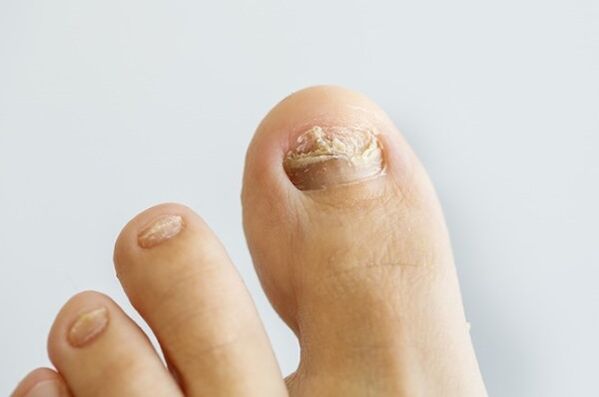
El daño fúngico a las piernas en las piernas en la práctica médica es mucho más común que una enfermedad similar en las manos. Esto se debe al hecho de que las extremidades inferiores están en contacto con mucha más frecuencia con el entorno contaminado. En este caso, la causa principal de la ocurrencia es la inmunidad reducida. El organismo debilitado no puede resistir completamente a un agente infeccioso.
Si hablamos específicamente sobre el hongo en las uñas de las piernas, hay una serie de factores que contribuyen a la infección:
- Visitar lugares públicos sin zapatos. Esto es especialmente cierto para baños, saunas y piscinas, duchas en gimnasios o en producción, departamentos de hospital en un hospital. En los dos primeros casos, el riesgo de infección es alto debido a la asistencia de tales lugares por parte de personas que son portadores de infección por hongos. Además, los hongos se multiplican más activamente en un ambiente húmedo. Los hospitales, a pesar del cumplimiento de los estándares sanitarios, son un lugar de concentración de diversas infecciones, incluidas las de hongos. Después de haberse vuelto descalzo en el piso en uno de estos lugares, la probabilidad de obtener una infección crece diez veces.
- En ausencia de limpieza regular utilizando química agresiva, su propio baño también se convierte en una plántula de infección fúngica. Incluso si ninguno de los domésticos estaba enfermo de onicomicosis, hongos patógenos condicionalmente que viven de la piel humana se multiplican en el baño sin acaparamiento. Un aumento en su población conduce a consecuencias deplorables.
- Usar los zapatos viejos u otras personas, los hongos patógenos condicionalmente patógenos están en la piel, es inevitable sus zapatos (especialmente de tipo cerrado). Los microorganismos se acumulan en capas de tejido, lo que también aumenta el riesgo de infección.
- Wearing shoes is not seasoned: one of the infection factors is excessive legs of the legs.If a person walks with closed shoes in the summer or wears warm shoes in the room, increase the probability of fungal damage.However, the newspaper of the nails and the negligible washing of the legs with soap may not be enough.It is important to cut the nails regularly, cut the burrs and push the cuticles, use special lotions and constantly clean the keratinized skin of the skin.In such cases, blood circulation is altered in the damaged area, the nail does not receive the right amount of nutrients.This can cause the development of the fungus.
- Types of fungi and characteristics of damage to the nails on the legs
- The characteristics of the treatment depend on the identification of the species of fungi that affect the nail plate.This is due to the possibility of selecting medications that show activity in relation to a particular type of pathogen and the implementation of the most effective treatment.
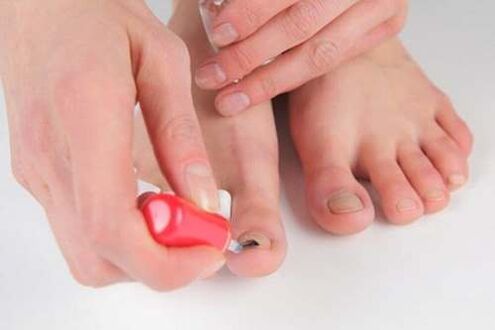
Dermatophytes
The most common type of pathogen.According to statistics, dermatophytes cause a fungus on the nails of approximately 75-80% of cases.It is in this case that the state of the immune system occupies the main role in the appearance of onychomycosis.With normal immunity, fungal damage to dermatophytes is almost impossible.Ceratinocytes, the cellular structures of the epidermis, whose high content is observed in the nails is a favorite means of nutrition of this type of fungus.
El tipo más común de patógeno. Según las estadísticas, los dermatofitos causan un hongo en las uñas de aproximadamente el 75-80% de los casos. Es en este caso que el estado del sistema inmune ocupa el papel principal en la aparición de onicomicosis. Con la inmunidad normal, el daño fúngico a los dermatofitos es casi imposible.
La infección proviene de personas o animales que son portadores, así como en contacto con el suelo. Los ceratinocitos, las estructuras celulares de la epidermis, cuyo alto contenido se observa en las uñas es un medio favorito de nutrición de este tipo de hongo.
Two main subspecies are distinguished in the caste of dermatophytes, with most aschomicosis pathogens:
- Red trichophite (Rubrum): The beginning of the pathological process occurs in the part of the end (external or free) of the nail, from where the infection gradually moves to the root of the nail plate.In most cases, it is this subspecies that affects the fingers of the feet.It is characterized by simultaneous damage to the nails in several fingers (often standing nearby).The characteristic signs of infection are the thickening of the affected area of the nail and its delamination.The skin under the outer facet of the nail plate dries and says goodbye.The favorite subspecies habitat is wet, is often found in bathrooms, bathrooms, swimming pools.The causal agent affects more often the thumbs of the lower extremities, after which "captures" other nails.A characteristic feature is considered to be focal damage to the nail plate with the appearance of separate white spots or strips.In the future, whitish areas grow, merging together.When fungal life forms extend to other fingers, there are areas of dry skin and peeled between the fingers.They are considered conventional and pathogens due to the fact that they constantly live on the surface of human skin.That is, for infection, contact with an infected person, animal or external environment does not need at all.In this case, the main trigger for pathology is a significant decrease in immunity, immunodeficiency.
Levadura
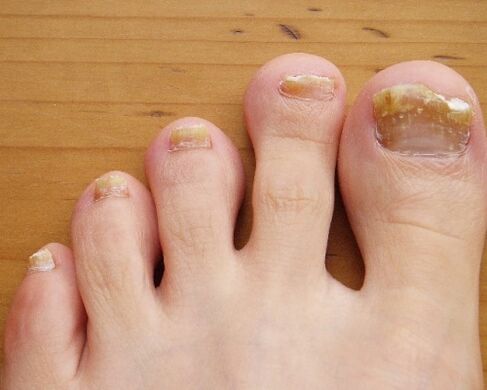
Otro patógeno de daño fúngico a las piernas en las piernas es los hongos patógenos condicionalmente de la familia Candida. Se consideran convencionales y patógenos debido al hecho de que viven constantemente en la superficie de la piel humana. Es decir, para la infección, el contacto con una persona infectada, animal o entorno externo no necesita en absoluto. En este caso, el desencadenante principal de la patología es una disminución significativa en la inmunidad, la inmunodeficiencia.
Unlike dermatophytes, yeast fungi do not form a layer of mycelium, that is, the destruction of the nail plate with this form of damage occurs much less frequently.But the same factor makes the infectious lesion heavier, since the beginning of the pathological process acquires the root (proximal) side of the nail.Such variety varieties are considered more serious, but at the same time rare.Because of this, the nail loses its brightness, becomes opaque and rough.The damage to the nails with yeast fungi occurs in approximately 7-10% of the cases.Fungal damage to the nail in the leg can cause approximately 35-40 subspecies of molds.In part, therefore, as well as due to an atypical clinical image, mold is more difficult to diagnose and treat.Another reason for the complexity of the diagnosis of bun in oppicycosis is the ability of mold fungi to form mycelium, which makes the clinical image the drawing with damage to dermatophytes.They progress slowly.In the initial stages, the fungus can go unnoticed at all.But there are still symptoms of the early stages of the development of pathology, which are important to pay attention:
Moldes
El tipo más insidioso de hongos, ya que estas formas de vida se encuentran en casi todas partes (pero especialmente en un entorno húmedo). El daño fúngico a la uña en la pierna puede causar aproximadamente 35-40 subespecies de moldes.
A pesar de la prevalencia en el medio ambiente, esta forma de onicomicosis rara vez se diagnostica. En parte, por lo tanto, así como debido a una imagen clínica atípica, el moho es más difícil de diagnosticar y tratar. Otra razón para la complejidad del diagnóstico de moño en ondicomicosis es la capacidad de los hongos de moho para formar micelio, lo que hace que la imagen clínica sea el dibujo con daño a los dermatofitos.
Las formas de vida fúngica afectan principalmente las uñas en las piernas, y la infección con subespecies es de aproximadamente 10-15%.
Imagen clínica
La mayoría de los tipos de daño fúngico a las placas de uñas progresan lentamente. En las etapas iniciales, el hongo puede pasar desapercibido en absoluto. Pero aún hay síntomas de las primeras etapas del desarrollo de la patología, que son importantes para prestar atención:
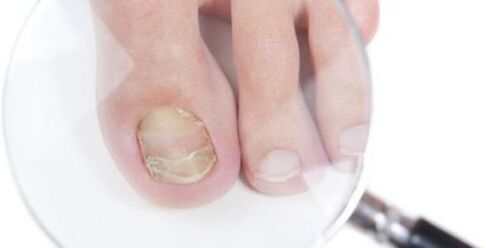
- Growth violation is the first and most discreet.In a standard state, the nail in the leg grows in no more than 2 mm per week.The nail plate, affected by the fungus, slows down the growth rate.It also indicates the appearance of white or yellow interspersed on the surface of the nail or a complete change in the color of the nail plate (white, yellow or brown tones is possible).Change the color of the nail fungus in the photo above.If the burrs began to appear more frequently, and the area of the cuticle is systematically inflamed or damaged, it is worth verifying if there is a fungal lesion.
- Thickening or thinning of the nail plate: the variations depend on the damage to the specific types of fungi.The clinical signs of the posterior stages of the onychomycosis include:
- Changing the surface of the nail plate: it becomes rough and unequal, sprinkled with tubers and waves.Also in the nail, similarities of the crumbs may appear, indicating a gradual detachment of the upper layer of the nail.Initially, this is expressed in the stratification of the nail plate, the appearance of cracks throughout the surface or splinters on the outer edge.This is how this feature of the fungus on the nails of the legs in the photo is seen.
- In the future, destruction is even more severe.The nail literally falls apart, without having time to grow.At the same time, the sub -gene sections of the dermis are exposed, and the remaining parts of the nail look clearly painful and unattractive.As a result, there is a risk of complete destruction or detachment of the nail plate.Severe lesion with a nail fungus in the photo above.
- Cambiando la superficie de la placa de la uña: se vuelve áspero y desigual, salpicado de tubérculos y olas. También en la uña, pueden aparecer similitudes de las migajas, lo que indica un desprendimiento gradual de la capa superior de la uña.
- En las etapas incluso posteriores, la uña comienza a colapsar gradualmente. Inicialmente, esto se expresa en la estratificación de la placa de la uña, la aparición de grietas en toda la superficie o astillas en el borde exterior. Así es como se ve esta característica del hongo en las uñas de las piernas en la foto.
- En el futuro, la destrucción es aún más severa. La uña literalmente se desmorona, sin tener tiempo para crecer. Al mismo tiempo, las secciones sub -Gear de la dermis están expuestas, y las partes restantes de la uña se ven claramente dolorosas y poco atractivas. Como resultado, existe el riesgo de destrucción completa o desprendimiento de la placa de uñas. Lesión severa con un hongo de la uña en la foto de arriba.
The danger of complications
Many unpleasant sensations and the deterioration of the appearance of the nails of the legs are only the upper part of the iceberg.The lack of timely treatment threatens the development of complications, among which are considered the most common:
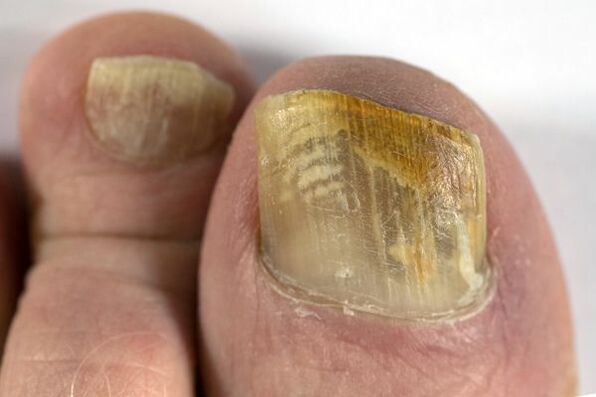
- Allergic reactions: In certain stages of development, the body can perceive the fungus of the legs as an allergen.infections in the affected areas.As a result, inflammatory and purulent processes are developed.
- Particularly serious cases, subject to prolonged course and the progression of the disease, can lead to the development of fungal mycosis.In this case, fungal life forms can penetrate blood and will be spaced throughout the body.
- Treatment methods
- For the maximum effectiveness of the treatment of nail fungus in the legs, complex therapy is often used.At the same time, it is previously important to make diagnoses sowing in a bacterial environment to determine the type of pathogen and choose the most effective medications.An integrated approach implies the combination of various types of therapy, but sometimes this is not enough.As part of the treatment, two main medicines are used, depending on the stage of development of the pathological process:
Para la máxima efectividad del tratamiento del hongo de las uñas en las piernas, a menudo se usa la terapia compleja. Al mismo tiempo, anteriormente es importante realizar diagnósticos sembrando en un entorno bacteriano para determinar el tipo de patógeno y elegir los medicamentos más efectivos. Un enfoque integrado implica la combinación de varios tipos de terapia, pero a veces esto no es suficiente.
Medicamentos
La terapia farmacológica es la base para el tratamiento de la mayoría de las patologías, incluidas las lesiones de uñas fúngicas. Como parte del tratamiento, se utilizan dos grupos principales de medicamentos, dependiendo de la etapa de desarrollo del proceso patológico:
- Local action type: these include ointments, gels, varnishes, creams, aerosols and lotions with antifungal activity.The method, multiplicity and duration of the use of such medications are determined by a doctor, but in most cases at least 2-3 weeks are used.For the most part, these are tablets that, after sucking the gastrointestinal tract, penetrate blood and inhibit fungal life forms, and do not allow mycosis to spread.The use of systems is important not only to improve the therapeutic effect, but also in order to prevent relapsesPopular recipes can improve the antifungal effect.They are considered the most effective of them:
- iodine: it is capable of dissolving protein structures, which are the basis of fungal life forms.For treatment daily, apply a few drops of iodine to the affected areas with a cotton pad.
Peroxide is an effective antibacterial agent that has a disinfectant effect.To improve the effect, peroxide is mixed in equal proportions with vinegar.Then, the patient lubricated with a mixture, it is not necessary to rinse it.The procedure is repeated daily for 1-2 weeks.To do this, take a tablespoon of crushed raw materials (leaves and twigs), pour 0.5 liters of water and boil.The decoction is defended in 15-20 minutes, after which the legs are submerged for another 20-25 minutes.Repeat the procedure daily before bedtime for 2-3 weeks.
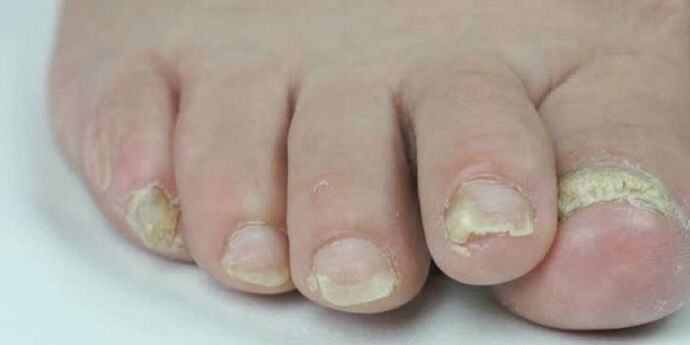
- Yodo: es capaz de disolver estructuras de proteínas, que son la base de formas de vida fúngicas. Para el tratamiento diariamente, aplique unas gotas de yodo a las áreas afectadas con una almohadilla de algodón.
- El peróxido es un agente antibacteriano efectivo que tiene un efecto desinfectante. Para mejorar el efecto, el peróxido se mezcla en proporciones iguales con vinagre. Luego, el paciente se lubricado con una mezcla, no es necesario enjuagarla. El procedimiento se repite diariamente durante 1-2 semanas.
- CELELTINE: el mejor método para usar esta planta para el tratamiento de hongos en las uñas de las piernas es las cataplasmas. Para hacer esto, tome una cucharada de materias primas trituradas (hojas y ramitas), vierta 0.5 litros de agua y hierva. La decocción se defiende en 15-20 minutos, después de lo cual las piernas se sumergen durante otros 20-25 minutos. Repita el procedimiento diariamente antes de acostarse durante 2-3 semanas.
Eliminating the nail
Today in medical practice, the chemical method to remove the nail plate is mainly used.For this, special aggressive medications are used, the procedure is carried out by a doctor so as not to damage healthy areas of the nail and skin.This method is painless and effective, and the indications for its use are the absence of the results of the conservative treatment or the advanced cases of onylomycosis.
Laser therapy
The procedure implies the partial or complete elimination of the nail plate.The choice of the method depends on how deeply the fungus will penetrate the nail structure.In the course of laser therapy, an intensive method of laser irradiation is used.A special device with a fungus layers of the nail is eliminated, after which an antimicotic therapy course follows.In this case, after elimination, a bandage is applied to the bare areas of the skin, under which an ointment or cream can be placed with an antifungal effect.The elimination of the nail plate requires regular visits to the doctor to carry out dressings and monitor the growth of the new nail plate.If the elimination is shown, the procedure disappears and takes about 20 minutes, the patient does not feel pain.

El tratamiento con láser del hongo de las uñas en las piernas, durante el cual solo se eliminan unas pocas capas de la uña, se llevan a cabo en etapas, dentro de 7-10 procedimientos (se requieren aproximadamente 10-15 minutos para procesar cada uña). Si se muestra la eliminación, el procedimiento desaparece y toma unos 20 minutos, el paciente no siente dolor.

















